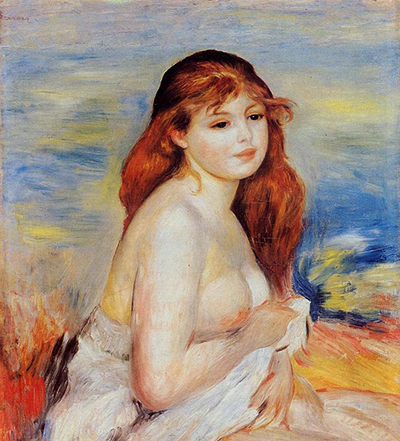Pierre-Auguste Renoir painted Bather most probably at some point between 1895 and 1890, so it was at the mid point in his career
Born in 1841, Renoir lived until 1919 and during that time he painted a variety of art works. Almost all of them were oil on canvas paintings and though he began by painting in a somewhat Impressionistic style, Renoir altered his style in the 1880s to take his own route - adding more discipline and realism (two good examples of realist artists would be Edward Hopper and Ilya Repin) into his works of art.
Bather was thus painted at the point in Renoir's career when his own style of painting had been very much consolidated and when his move away from Impressionism had been shown to be a definitive one, though his works in this later period retained the vividness, luminosity and warm emotional quality that they had always had. For Renoir, see also The Bathers, Bather with Long Hair, Bathers in the Forest, Nude Bather Seated by the Sea, Seated Bather, The Bathers II and The Large Bathers
At first glance, Bather depicts a rather everyday subject: a woman, turned slightly away from the viewer, is fixing her hair. She is nude, and has evidently either just been bathing and swimming or she is about to do so. A white towel is placed underneath her, and the scene around her is of flowery woodlands - she is clearly someone who enjoys bathing out in the great outdoors.
The whole mood of Bather is quietly joyous: the woman and her surroundings are conveyed with glowing tones, and the paints have been blurred slightly to give the whole work a somewhat fuzzy and dreamlike edge.
Look more closely at Bather, though, and it definitely reveals Renoir's newfound fascinating with classical nudes. In the early 1880s, he had taken a trip to Italy, and the amazing classical sculptures that he saw there endowed him with a renewed interest in the nude female form. Though it is a painting rather than a sculpture, Bather is certainly designed to replicate - in part at least - the lines and curves that Renoir so admired during his trip to Italy. Turner and Singer Sargent would also both be inspired by trips to Venice.
Another aspect of Bather that ought to be taken into account is the eponymous bather's skin, which has a light and luminous quality. She seems to glow with an inner vitality, which perhaps lends strength to the thesis that we are looking at someone who is fresh from a bracing swim. Renoir's ability to make his sitters' skins look luminous in this way was remarked on throughout his career - and it continues to be remarked upon now.
Note, too, the care with which the bather's surroundings have been painted. Renoir often set his sitters in the middle of beautiful landscapes, which he painted with detail to make them stand out. We can see this in many other portraits set outdoors, such as the nearly contemporaneous 'Sailor Boy', for example. Speaking of Renoir's other works of art, it is noteworthy that he came back to the theme of bathers at several points in his career. Shortly before his death, for example, he painted a depiction of a pair of bathers, which is usually just referred to as 'The Bathers'.




